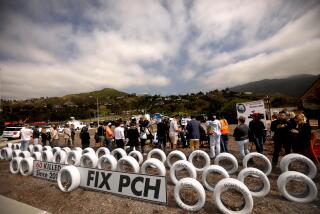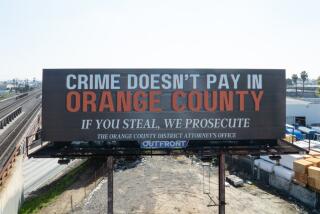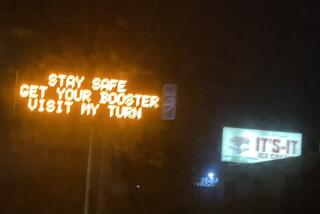Ads Show Horrors of Rail-Crossing Accidents
WASHINGTON â On screen the teenagers laugh and joke in their car as they wait for the train to pass. It does, and they pull out--into the path of another locomotive on a second track. The camera pulls back to show the car being battered violently along the track.
Itâs one of a set of new âshockâ ads aimed at warning Americans of the dangers of railroad crossings. The goal is to scare people. Based on the previews, it will work.
âThe announcements are graphic because we want to get peopleâs attention,â said Gerri Hall, the head of Operation Lifesaver, which works to bring attention to the dangers of railroad crossings and trespassing on tracks.
âIf the spots are scary, theyâre nothing compared to the real thing,â said Transportation Secretary Rodney Slater. The new ads were tested in Texas last year and crossing deaths fell by 10%, he said.
âIf youâve never seen the body of a grade-crossing victim, you donât realize the horror of these accidents,â said U.S. Rep. Spencer Bachus (R-Ala.), whose father, an engineer, once jumped from his train moments before it struck a gasoline truck.
Last year 471 people died in accidents at highway-rail crossings and 472 were killed in accidents while trespassing on railroad tracks. That was down from 579 crossing deaths and 494 trackside fatalities in 1995.
Operation Lifesaver was founded in 1972 when crossing fatalities alone topped 1,200. Today it operates chapters in every state except Hawaii. Federal officials estimate that the program has saved 10,000 lives in its 25 years of efforts to warn the public.
The latest push includes print and radio ads as well as the graphic television presentations.
The ads were put together with assistance of the Assn. of American Railroads and will be offered as public service spots and paid ads across the country, Hall said. The broadcast versions cost about $50,000 each to make.
Aside from the car demolished at a double crossing, a second ad shows a man deciding to drive past a closed warning gate because the drivers behind honk impatiently. He drives his family into the path of a speeding train with deadly results, again shown on screen.
The third ad opens with a crew of jovial children walking along a trestle when they hear a train. They sprint to the side, but one doesnât make it. Suddenly the camera is in his place, looking up as the locomotive roars over him.
Eyes closed and heads turned away in the audience at Washingtonâs Union Station. But one face, jaw set, stared intently at the giant screen.
Astrid Harvey of Los Angeles watched, unflinching.
She knows the horror of such a tragedy all too well. A baby sitter was walking her 4-year-old son, Christian, along a track when he was struck by a train moving at 70 miles per hour.
Today she tells her story in hopes that other parents will learn from it.
âI will never forget the words: âThere has been an accident and your son didnât make it.â I will never forget my ex-husbandâs screams when he learned his son was dead,â she recalled. âThis has been a very difficult year, a year of sorrow, a year of pain.â
More to Read
Sign up for Essential California
The most important California stories and recommendations in your inbox every morning.
You may occasionally receive promotional content from the Los Angeles Times.










